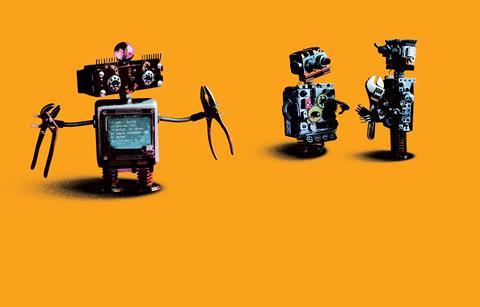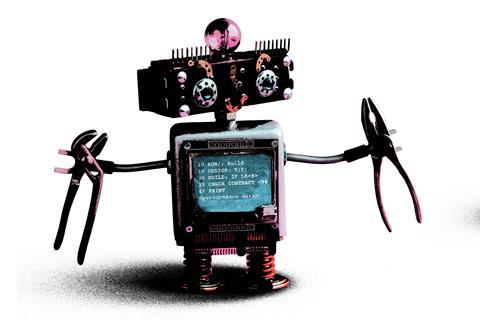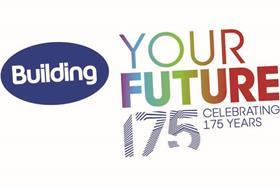Artificial intelligence is set to play a major part in construction. Where does that leave the humans who work in the sector? Joey Gardiner asks leading experts how future developments are likely to change the way things are done – and what consultants can do to stay relevant

Is your job safe from computer automation? It’s a question construction consultants will increasingly have to start asking themselves. And if you think you’re immune, you might need to think again.
We may be used to the idea of robot automation on manufacturing production lines, but white-collar professionals are now feeling the heat from new digital technologies, particularly artificial intelligence (AI), given the exponential growth in computing power and algorithm-based computer systems. There is talk of automated nurses, even judges. A 2013 report from Oxford university estimated that 47% of all US jobs were at a high risk of automation in the next 20 years, including “a substantial share of employment in […] construction occupations”. Most recently, PwC reported that 20% of all UK jobs were at risk of automation by the mid-2030s.
For consulting firms working in UK construction, the rise of digital technologies such as AI, the “internet of things” and blockchain is, of course, a huge potential opportunity as well as a threat. For many, it is opening up the possibility of consultants’ more routine tasks – drawing up cost schedules or engineers’ calculations – being largely automated, freeing up time for more creative endeavours. And according to a report published last autumn by construction firm Mace, these technologies are coming quickly – with a widespread effect from AI and process automation likely within 10 years.
Many are optimistic that more jobs will be created than destroyed by this so-called “fourth industrial revolution”. But there is no guarantee that new jobs will require the same skills, while, more broadly, there are fears that automation could further the commodification of what were once highly valued professional services. So as part of our Building Your Future campaign, we’ve asked how technology will affect the industry’s architects, surveyors, engineers and project managers, and whether a race to the bottom can be avoided.
Potential
Richard Steer, worldwide chairman of consultant Gleeds, describes a recent demonstration of a prototype showing – he says – the potential of combining detailed construction data with powerful computers armed with sophisticated algorithmic models. “We had Amazon’s Alexa in the middle of the table and said to it we wanted to build a 100-room hotel. It came back with ‘That will cost you £28m to build and take you 2.5 years’ – a basic cost plan and schedule just like that.
Yes, it was a bit set up – but you can see the potential power of this.” The potential impact of this on unreconstructed cost consultants is not hard to imagine.
There is a huge range of ideas as to where exactly new technology will take consultants – but the broad direction of travel is common to many visions of the future. Commonly, the first element is the capturing of huge amounts of construction and post-occupancy data through the placing of thousands of sensors on plant, machinery, people and completed buildings, all connected up through the internet of things, to give a picture of how building sites and buildings can perform to a level never previously imaginable. Then, the idea is that computers, containing carefully honed algorithms, machine learning, huge processing power and – vitally – this wealth of data, can start undertaking key tasks with minimal human input, from contract management, cost plans and estimating, to the actual design of buildings.
“You could easily commodify the process of architecture; it’s a great fear”
David Nelson, Foster + Partners
Sebastian Wood, managing director at start-up engineering firm Whitby Wood, says: “We’re all familiar with spreadsheet technology on one hand, and [computer] games like Minecraft, where you can build cities with a flick of a button, on the other. It doesn’t take a genius to see we could potentially do things quite differently.
“We’re going to a place where a client rings up to talk about a building – and you can literally put something together for them in minutes. Things like engineering calculations can be done incredibly quickly – it’s just about computing power. For me it’s not about if this is going to happen – the conversation is about who is going to focus on it and do it first.”
Huw Thomas, a former partner in architect Foster + Partners, and founder of start-up Data Dig, says project financiers and insurers will drive take-up of this by requiring an increasing amount of detailed information on projects from the outset. “They’re going to be asking for detail, and asking why you don’t know this about your projects, or saying they’re only going to insure against projects with a smart contract.” Thomas predicts that in a decade, as much as 75% of the work of issuing a tender could be automated.
In case the sector is tempted to opt out of this digital revolution, there is the threat that the likes of Google – already employed by Toronto to develop a “smart city” on its waterfront – will step in and do it for them. Will Waller, head of futures at consultant Arcadis, says: “The risk is someone comes in from outside and eats your lunch” – construction’s equivalent of how taxi app Uber has laid waste to competitors in that sector. Matt Gough, director of innovation at Mace, says: “We need to be quite ambitious and entrepreneurial, because if we don’t there are so many companies circling, looking to take advantage.”

What is …?
Artificial intelligence
Often abbreviated to AI, this is technology that allows computers to carry out tasks – such as driving a car – that would normally be thought to require human intelligence. Machine learning is an application of AI in which “smart” computers are given access to large amounts of data and allowed to learn from it.
The internet of things
This is the idea of a network of connected devices that can communicate with each other, often without direct human input. In the built environment this can potentially allow sensors placed on buildings and building sites to feed in a huge amount of data about the real-time performance of buildings and construction efforts.
Blockchain
The technology behind cryptocurrency Bitcoin, Blockchain is essentially a way of providing secure records of transactions via a ledger distributed over the internet, protected by strong encryption. Potential applications for construction include payment management, arbitration, and record keeping for collaborative design efforts.
Frightening
This doesn’t mean, however, that anyone expects that engineer, surveyor or architect roles will become redundant. Hanif Kara, co-founder of consultant AKT II, says: “At the sharp end it’ll be about combining the brute force of amazing computational power with the skill of seasoned engineers.” But the thrust of job roles could change, reducing time needed for the vital but often repetitive calculations and other tasks that were once at the heart of professionals’ competencies. Data Dig’s Thomas says: “The drudgery work will inevitably be taken on by machines, which takes some of the employment away from consultants.”
For some, this could be a relief. “Our view is that if you can save a day a week of your time, to be more strategic, or do other things, then bring it on,” says Mace’s Gough.
There will be a need for professional staff able to programme, direct and control the machines, and, vitally, provide the creative input needed to prevent algorithmic standardisation. As well as engineers and surveyors with programming skills, Arcadis’ Waller says: “The opportunity is there for professionals to boost their skills in areas where humans are better than machines. We’ll need more creativity, abstract thinking and the ability to deal with uncertainty – that’s the sweet spot.”
“We need to be quite ambitious and entrepreneurial, because there are so many companies circling”
Matt Gough, Mace
But it’s clearly daunting. Gleeds’ Steer has been going around his business in recent months, talking about his vision of the future to staff, including his opinion that technology could start to erode the traditional distinctions between professions. He says: “You finish up, and everyone’s a bit quiet in the room. I ask them whether they found it all frightening or exciting. Clearly it’s both.”
His view is that this technological change represents a “Kodak moment” for the sector – a reference for the photography giant’s notorious failure to grasp the shift from film to digital images. Frank McLeod, head of project technology at consultant WSP, says the risk is that this technological revolution simply exacerbates the existing drive to commodify professional services: “If we use automation to simply drive down the cost and time of delivery so we can maintain market share, then it becomes a race to the bottom,” he says. “We think that’s not sustainable.”
David Nelson, head of design at Foster + Partners, agrees this is a real risk. “You could easily commodify the process of architecture; it’s a great fear.”
Meanwhile, many believe the growth in communication and collaboration technologies and the gig economy are nibbling away at the justification for large firms in the first place. In the new world, where teams of talented people can be brought together to form integrated project teams and then disbanded, the infrastructure – offices, pensions, management – of big organisations starts to look like unnecessary overheads. Waller agrees that this is a potential threat. “We can see a world where internet-based platforms grow up where groups of people offer consultant-like services in a non-traditional way, which enables them to be quite agile,” he says.
How firms respond, in a world where fees are already vastly reduced from a generation ago, will clearly be vital. McLeod’s answer for WSP is to seek to “move back up the slope” by becoming a “trusted adviser” to its clients, more akin to a management consultant for the built environment: one that simply happens to have “a very efficient machine” for delivering construction documents. “It’s a different model entirely,” he says.
Many of the big firms, such as WSP, Aecom and Turner & Townsend, now boast in-house programming teams, while Mace has just set up a client-facing IT function. Meanwhile, Steer says he expects the winners over the next generation to be those firms with the best ability to control and manipulate the vast quantity of data that is expected to be generated.
Waller says: “If you look at history, technological innovations have never destroyed jobs overall. But there will be winners and losers, individually and organisationally, and the losers will be anyone not willing to change.”

Big question
Despite all this, few envisage wholesale change in construction overnight. Barriers include the sector’s relatively poor research and development and investment levels, the fragmented nature of the industry and question marks over the regulation and use of the data many envisage powering this digital revolution. Waller says: “It’ll all take much longer than people think.”
Certainly, with the controversy over Facebook’s use of customer data still making headlines, this data issue may be harder to resolve than many expect. It’s not clear how consultants could use information collected from a project to inform work for other clients, even if anonymised.
Guy Beaumont, digital infrastructure lead at consultant Turner & Townsend, says: “We don’t harvest data from clients – we work on behalf of them. There’s a great deal of commercial sensitivity over, particularly, cost data in the construction industry, so we sign non-disclosure agreements with all of them. Construction isn’t there with open data yet.” Ian Scull, innovation champion in consultant Aecom’s infrastructure business, says: “Data is the new oil. But the industry is feeling its way at the moment – it’s something that will need to be resolved.”
Nevertheless, the big question remains one of where and when to invest in meeting these new challenges, and in a way that protects them against McLeod’s “race to the bottom”. For Foster + Partners’ Nelson, key to this will be stressing the uniquely human and emotional content of what designers provide. “Buildings and places directly affected the lives of people in every
way, including a big emotional and sensory content,” he says. “Automation tends to standardisation, which leads to boredom. We’ll need a degree of sensitivity and emotional intelligence to ensure buildings don’t just come from the brain but the heart too. The industry will need to be more overt about this.”
While engineers and surveyors who pride themselves on their ability to grasp numbers may balk at this message, it could prove, ultimately, to be the best case human consultants can make.
Technological advances
New technologies could automate a huge range of professional services in construction, such as:
Procedural design
Computers with sophisticated algorithms can already perform basic design functions, and can be assumed to be likely to take on much more complex tasks. Frank McLeod, head of project technology at WSP, says this often takes the form of “procedural design”, where the machine will run along drawing up a design until a human intervenes to take over the decision-making process. He says WSP does this with residential developments, where technology is used to try out concepts – if you change the dimensions of a building it automatically “fills in” the detail.
Smart contracts
These are contracts of engagement that computers are programmed to “understand” the meaning of. Computers can then track delivery against contractual stipulations automatically, potentially triggering payment or other actions automatically when contractual milestones are met. Payment could be automated using blockchain technology.
Problem flagging
Ian Scull, innovation champion at Aecom, says current clash-detection technology, available in building information models, “is stone age technology compared to where we’re going”. He says tools are being developed that check design work as it is going along. This means that if you’re designing a bridge, the checking tools might automatically assess the impact of any design changes on passenger flows or air quality – flagging issues that may be outside the specific designer’s discipline, and which therefore wouldn’t otherwise be picked up until much later in the process.


























1 Readers' comment